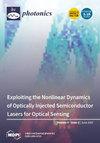通过散射体产生宽路径长度分布实现高动态范围吸收光谱学
IF 2.1
4区 物理与天体物理
Q2 OPTICS
引用次数: 0
摘要
在吸收光谱学中,要在一次测量中检测出强度差异显著的吸收峰是一项挑战。我们通过在样品中分散散射体来形成广泛的路径长度(PL)分布,从而实现高动态范围测量。将样品置于积分球(IS)内,可捕获各种路径长度的所有散射光。为了解决积分球和样品内部 PL 的复杂性,我们使用蒙特卡洛(Monte Carlo,MC)方法进行了光线跟踪模拟,该方法可根据样品的吸收系数 µa 和每个波长 λ 的散射特性估算出测得的吸光度 A 和 PL 分布。结果表明,在一次测量中就能勾勒出两个峰形,而不会使高吸收峰变平。虽然测得的峰形 A(λ) 与实际峰形 µa(λ) 并不一致,但 MC 能够根据 A(λ) 重现 µa(λ)。此外,MC 对 PL 分布的分析表明,增加散射体会使分布变宽,并随着吸收的增加而向更短的 PL 方向移动,从而有效地将其调整为 µa。本文章由计算机程序翻译,如有差异,请以英文原文为准。
High-Dynamic-Range Absorption Spectroscopy by Generating a Wide Path-Length Distribution with Scatterers
In absorption spectroscopy, it is challenging to detect absorption peaks with significant differences in their intensity in a single measurement. We enable high-dynamic-range measurements by dispersing scatterers within a sample to create a broad distribution of path lengths (PLs). The sample is placed within an integrating sphere (IS) to capture all scattered light of various PLs. To address the complexities of PLs inside the IS and the sample, we performed a ray-tracing simulation using the Monte Carlo (MC) method, which estimates the measured absorbance A and PL distribution from the sample’s absorption coefficient µa and scattering properties at each wavelength λ. This method was validated using dye solutions with two absorption peaks whose intensity ratio is 95:1, employing polystyrene microspheres (PSs) as scatterers. The results confirmed that both peak shapes were delineated in a single measurement without flattening the high absorption peak. Although the measured peak shapes A(λ) did not align with the actual peak shapes µa(λ), MC enabled the reproduction of µa(λ) from A(λ). Furthermore, the analysis of the PL distribution by MC shows that adding scatterers broadens the distribution and shifts it toward shorter PLs as absorption increases, effectively adjusting it to µa.
求助全文
通过发布文献求助,成功后即可免费获取论文全文。
去求助
来源期刊

Photonics
Physics and Astronomy-Instrumentation
CiteScore
2.60
自引率
20.80%
发文量
817
审稿时长
8 weeks
期刊介绍:
Photonics (ISSN 2304-6732) aims at a fast turn around time for peer-reviewing manuscripts and producing accepted articles. The online-only and open access nature of the journal will allow for a speedy and wide circulation of your research as well as review articles. We aim at establishing Photonics as a leading venue for publishing high impact fundamental research but also applications of optics and photonics. The journal particularly welcomes both theoretical (simulation) and experimental research. Our aim is to encourage scientists to publish their experimental and theoretical results in as much detail as possible. There is no restriction on the length of the papers. The full experimental details must be provided so that the results can be reproduced. Electronic files and software regarding the full details of the calculation and experimental procedure, if unable to be published in a normal way, can be deposited as supplementary material.
 求助内容:
求助内容: 应助结果提醒方式:
应助结果提醒方式:


